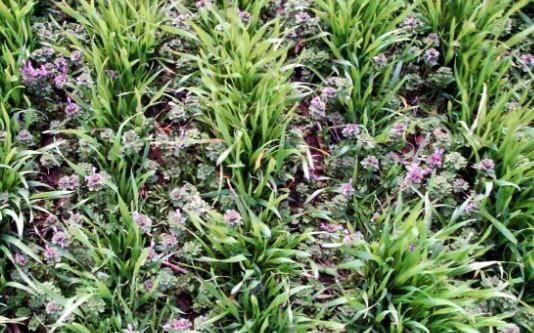Cheat/Downy Brome
In fields with cheat and downy brome infestations, herbicide applications are almost always warranted, especially when these grasses emerge at or within the first few weeks after wheat planting. Researchers in Oklahoma have observed a 49% reduction in wheat yield due to cheat infestations of 86 plants per square meter (Koscelny and Peeper, 1997). Similarly, wheat yield reductions greater than 60% have been reported in fields with 200 downy brome plants per square meter (Blackshaw 1993).
Italian Ryegrass
Much like the situation with cheat and downy brome, herbicide applications are almost always warranted for Italian ryegrass. This weed has a tendency to evolve resistance to herbicides, is capable of taking up nutrients like nitrogen and potassium at a greater rate than wheat, and is a very competitive species. There have been numerous studies done on the effects of Italian ryegrass on wheat yields, and they all show yield reductions. In one of the more recent studies conducted on this topic, Liebl and Worsham (2017) showed that wheat grain yields were reduced an average of 4.2% for every 10 Italian ryegrass plants per square meter.
Henbit/Purple Deadnettle.
Henbit is one of those weeds that does not compete as effectively with wheat as some of these other winter annuals weeds, but still could cause yield reductions when present at high enough densities. I would put purple deadnettle in this same category, but can't find any data to support that statement. Research we conducted in several locations in Missouri years ago showed that season-long competition from henbit at densities of 18 plants per square meter did not cause any wheat yield loss at all but densities of 82 plants per square meter reduced yields by 13%. However, the stage of growth that these species are in at the time you wish to treat is critically important. As I mentioned previously, almost all of the henbit and purple deadnettle I've seen in Missouri now is flowering or past flowering, and already starting to senesce and die back on its own. While a herbicide application might be justified from the standpoint of preventing seed production, chances are that these weeds are not going to be competitive enough with wheat to make it an economically justifiable treatment.

Some producers are asking what density of winter annual weeds justifies treatment in winter wheat. According to our research, henbit infestations like the one shown here are not always going to cause yield losses. It depends on the stage of the henbit and the wheat at the time of the application.
Wild Garlic
Although wild garlic is not considered much of a competitor with wheat either, control of wild garlic in wheat is usually necessary because of the dockage that will occur at the grain elevator if the bulblets of this species contaminate the harvested grain.
Source : missouri.edu